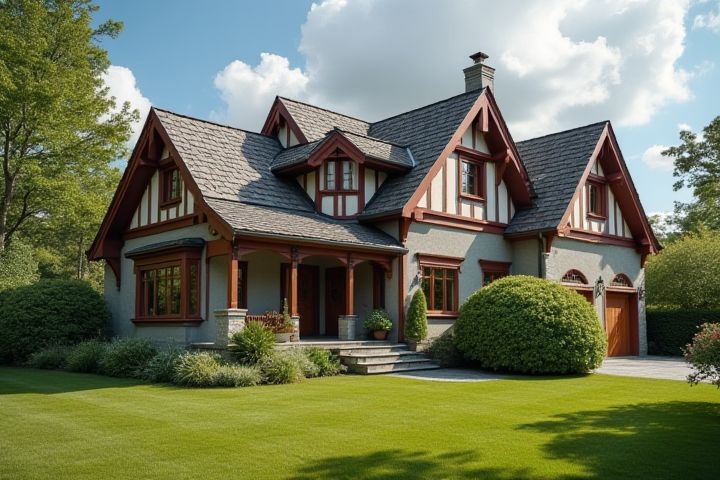
A house can indeed have too many upgrades, leading to diminishing returns on investment. Over-customization can alienate potential buyers, as they may prefer a more neutral or traditional style. For example, extensive high-end finishes, while visually appealing, might not align with neighborhood standards or buyer expectations. Furthermore, certain upgrades, such as luxury outdoor kitchens or elaborate landscaping, may not be necessary in moderate climates where outdoor entertaining is limited. Balancing upgrades with market value and buyer preferences is key to maintaining a property's appeal and ensuring a profitable resale.
Can A House Have Too Many Upgrades
Overpricing the Property
Overpricing a property often occurs when homeowners invest excessively in upgrades, leading to a home value exceeding market expectations. For instance, a kitchen remodel costing $50,000 may only yield a return of 60%, resulting in a financial disparity and a higher asking price. Features like extravagant landscaping or high-end appliances, while appealing, can alienate potential buyers who may not appreciate the style or expense. Knowing your local market and comparable sales is crucial, as too many upgrades can turn away buyers who perceive the asking price as inflated due to unnecessary enhancements.
Inconsistent with Neighborhood
A house can have too many upgrades if they are inconsistent with the surrounding neighborhood, affecting its resale value. For instance, spending over 30% more on luxury features in an area dominated by mid-range homes may deter potential buyers. By contrast, a well-matched home maintains a charming aesthetic and neighborhood appeal, which is crucial for attracting buyers. When you consider renovations, aligning with local trends and standards ensures your investment remains viable and appealing.
Limited Buyer Interest
Excessive upgrades in a house can lead to limited buyer interest, particularly if the improvements do not align with the preferences of the target market. For instance, if you invest $100,000 in high-end kitchen appliances in a neighborhood where the average home price is $300,000, potential buyers may perceive it as an over-improvement. The investment might not yield a return, especially if the majority of buyers in that area are looking for more modest features. Engaging with local real estate trends and understanding the demographics can help you avoid costly upgrades that fail to attract interested buyers.
Reduced Return on Investment
A house can indeed have too many upgrades, leading to a reduced return on investment (ROI). For instance, if you invest $100,000 in high-end renovations, you may only recoup 70% of that on resale, leaving a $30,000 loss. Over-improvement can alienate potential buyers who may prefer more standard features, especially in neighborhoods where homes typically sell for lower prices. It's crucial to balance upgrades with market trends, ensuring that each enhancement adds measurable value, aligning with local buyer preferences and expectations.
Overcapitalization Risk
Overcapitalization occurs when the total investment in a property exceeds its market value, which often happens through excessive upgrades. For instance, spending $100,000 on high-end kitchen renovations in a neighborhood where the average home value is $250,000 may yield a diminished return on investment. Homebuyers typically seek properties that align with local market standards, making overly extravagant features less appealing. Understanding the balance between enhancements and market expectations can prevent potential financial losses for homeowners.
Maintenance Costs
Excessive upgrades in a house can lead to significantly higher maintenance costs, potentially negating the initial investment. Premium materials, such as custom roofing or high-end appliances, often require specialized care and can increase repair expenses over time. You may also face elevated utility costs due to complicated systems, like smart home technology or advanced HVAC systems, which demand regular updates. Assessing the balance between home improvements and ongoing maintenance is vital to ensure your investment remains beneficial in the long run.
Appeal to a Niche Market
A house can have too many upgrades that cater solely to a niche market, potentially alienating a broader buyer pool. For instance, installing high-end gourmet kitchens or luxury home theaters may attract foodies or film enthusiasts, but could deter families looking for practical functionality. Excessive customization tailored to specific interests may result in diminished resale value, as prospective buyers might not appreciate or require those particular features. To maintain appeal, consider balancing unique upgrades with universally appealing elements that enhance overall livability and marketability.
Potential for Market Changes
A house with excessive upgrades may hinder its marketability, particularly if these enhancements do not align with current buyer preferences or neighborhood standards. While high-end finishes can attract certain buyers, they can also alienate potential purchasers who prefer more modest or practical features. Market fluctuations and economic conditions can render specialized upgrades less valuable, resulting in a potential loss on investment. It's essential to ensure that enhancements not only improve your home's enjoyment but also maintain alignment with market demands to optimize resale value.
Increased Property Taxes
Excessive upgrades can significantly raise your property's assessed value, leading to higher property taxes. In some cases, renovations may increase your home's worth by as much as 20% to 30%, which could result in annual tax increases that you may not have budgeted for. Overspending on luxurious features such as high-end kitchens or landscaped gardens might exceed the average home value in your area, making it challenging to recoup these costs upon sale. Weigh the benefits and costs of upgrades carefully to avoid financial strain from inflated property taxes.
Longer Time to Sell
A house with excessive upgrades can potentially increase the time it takes to sell, as buyers may prioritize practicality over luxury. For example, homes with high-end finishes or specialized features may appeal to a narrower audience, leading to a smaller pool of interested buyers. Statistics indicate that homes priced above the neighborhood average take 20-30% longer to sell, often because potential buyers struggle to see the value in over-customized features. When considering upgrades, focus on improvements that enhance functionality and appeal to a broader market to ensure a quicker sale.
